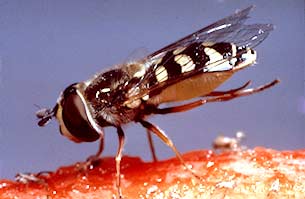The common Ladybug
 |
These bugs are so cute, and they have a powerful hankering for aphids!The ladybug is the most commonly recognized beneficial insect. Every gardener knows of the voracious appetite these insects have for aphids which has made ladybug a legend in folklore.
Ladybug! Ladybug!
|
 |
Identifying LadybugsThere are several species that bear the characteristic orange-red wing covers with black spots; these prefer aphids but will eat other soft-bodied insects as well. Ladybug larvae are black with orange spots, though they can vary to gray or light gray with spots that appear light orange or even yellow. The larval spotting pattern is variable, depending on species.
The ladybug lifecycle includes four stages: egg, larva, pupa, and adult. Both larva and adult prey on aphids. Generally the mature female will lay eggs on the underside of a leaf near a colony of aphids. The eggs are orange and have the shape of a rocket ship from old science fiction movies; they may be laid singly or in groups of up to 30, usually on the underside of a leaf near aphids. Now we don't want you to get the idea that this is the only kind of ladybug there is. Oh no, no, no! There are many kinds, and each has it's own food preference. Some eat mealybugs, some eat whiteflies, and some eat spider-mites. There is even one species, the Mexican Bean Beetle, that eats plants! Yikes! If I buy ladybugs, will they work?The ladybugs you find in your garden are very effective predators of aphids and they will also eat other soft bodied insects such as mealybugs. The ladybugs you buy, however, may be completely ineffective as pest control agents. At certain times of year, ladybugs in the west fly up to the mountains and aggregate to breed. They will cover a stump or rock so thickly that you can't even tell what they are on. This is where the collectors go to vacuum them up. Then the ladybugs are stored in refrigerators until they are sold. During the time the ladybugs are in the fridge, they are in suspended animation. When the collectors take them out, they still think it is time to fly up to the mountains. They are in this migration mode when you receive them, so when you release them in your garden, off they go, usually without eating a thing or laying any eggs. Because of this, we don't recommend them for pest control and you won't find them on our price list. If you are sure you definitely want to buy ladybugs, send us an email to imusthaveladybugs@betterbugs.com and we'll make the arrangements. Otherwise, use the lacewings; they have a much wider range of pests that they'll control, and they will stay where you put them. |

